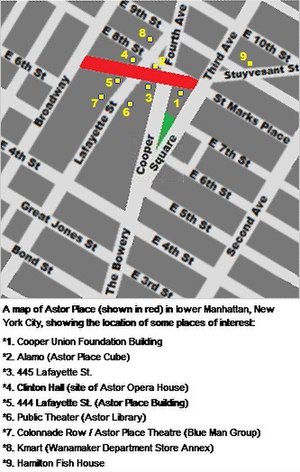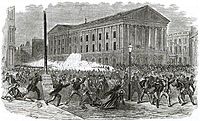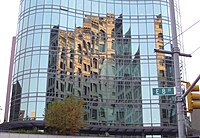Astor Place
40°43′47″N73°59′29″W/ 40.729861°N 73.991434°W

Astor Placeis a one-block street inNoHo/East Village,in thelowerpart of theNew York Cityborough ofManhattan.It runs fromBroadwayin the west (just belowEast 8th Street) toLafayette Street.The street encompasses two plazas at the intersection with Cooper Square, Lafayette Street, Fourth Avenue, and Eighth Street –Alamo PlazaandAstor Place Station Plaza."Astor Place" is also sometimes used for the neighborhood around the street.[1]It was named forJohn Jacob Astor(at one time the richest person in the United States), soon after his death in 1848.[2]A $21 millionreconstruction to implement a redesign of Astor Place[3]began in 2013 and was completed in 2016.[4]
Geography
[edit]TheAmerican Guide Seriesdescribes the Astor Place district as running from Houston Street north to 14th Street, between Broadway and Third Avenue.[5]The Encyclopedia of New York Citydefines the neighborhood as between 4th Street and 8th Street, from Broadway to Third Avenue.[1]
History
[edit]Astor Place was originally apowwowpoint for the variousLenapetribes ofManhattanand was called Kintecoying or, “Crossroads of Three Nations".[6]
Astor Place was once known asArt Street.From 1767 through 1859,Vauxhall Gardens,a country resort, was located on this street.[7]The area belonged toJohn Jacob Astor,and Astor Place was renamed after him soon after his death, in 1848.[2]In 1826, he carved out an upper-class neighborhood from the site withLafayette Streetbisecting eastern gardens from western homes. Wealthy New Yorkers, including Astor and other members of the family, built mansions along this central thoroughfare. Astor built theAstor Libraryin the eastern portion of the neighborhood as a donation to the city. Architect Seth Geer designedrow housescalledLaGrange Terracefor the development, and the area became a fashionable, upper-class residential district.[8]This location made the gardens accessible to the people of both the Broadway and Bowery districts.[9]
Astor Place was the site of theAstor Opera House,at the intersection of Astor Place, East 8th Street, and Lafayette Street. Built to bethefashionable theater in 1847, it was the site of theAstor Place Riotof May 10, 1849. Anti-British feelings were running so high among New York's Irish at the height of theGreat Faminethat they found an outlet in the rivalry between American actorEdwin Forrestand the EnglishWilliam Charles Macready,who were both presenting versions ofMacbethin nearby theatres. The protest in the streets against Macready became so violent that the police fired into the crowd. At least 18 died, and hundreds were injured. The theater itself never recovered from the association with the riot and was closed down shortly afterwards. The interior was demolished, and the building was turned over to the use of theNew York Mercantile Library.
From 1852 until 1936, Astor Place was the location of Bible House, headquarters of theAmerican Bible Society.[10]
In the mid- to late-19th century, the area was home to many of the wealthiest New Yorkers, including members of theAstor,Vanderbilt,andDelanofamilies. Editor and poetWilliam Cullen Bryant,and inventor and entrepreneurIsaac Singerlived in the neighborhood in the 1880s.[11]By the turn of the century, however, warehouses and manufacturing firms moved in, the elite moved to places such asMurray Hill,and the area fell into disrepair. The neighborhood was revitalized beginning in the late 1960s and 1970s.[1]
TheNew York City Department of Transportation's "Reconstruction of Astor Place and Cooper Square" plan[3]called for some changes to be made to Astor Place beginning in 2013. The street would end at Lafayette Street rather than continuing east toThird Avenue.This allowed the expansion of the "Alamo Plaza", where theAlamo Cubeis located, south to the southern sidewalk of Astor Place between Lafayette Street and Cooper Square, and the creation of an expanded sidewalk north of the Cooper Union Foundation Building. The Astor Place subway entrance plaza was also redesigned, and Fourth Avenue south of East 9th Street and the western part of Cooper Square was converted to be used by buses only, with a new pedestrian plaza created on Cooper Square between East 5th and 6th Streets. The traffic pattern of the area changed significantly, with Astor Place from Lafayette Street to Third Avenue becoming East Eighth Street eastbound, and the formerly bidirectional Cooper Square bus lane becoming northbound-only.[3]The $16 million project[12]was first proposed in 2008, then abandoned and re-proposed in 2011. Construction started in September 2013,[13]and the work was completed in November 2016.[4][14]
Points of interest
[edit]

The current 299-seatOff-BroadwayAstor Place Theatre,has been located in the landmarkColonnade Rowon Lafayette Street, half a block south, since 1969. It was known for premiering works by downtown playwrights likeSam Shepard,but since 1991 has been the home ofBlue Man Group,which now owns the theatre. The Joseph PappPublic Theater(home to theNew York Shakespeare Festival) is located across the street in the formerAstor Librarybuilding.
The trapezium-shapedtraffic islandin the center of Astor Place is a popular meeting place and center of much skateboarding activity. The island is most notably home toTony Rosenthal'ssculpture "Alamo",known popularly as" The Cube ", which consists of a large, black metal cube mounted on one corner. Installed in 1967 as part of the" Sculpture and the Environment "organized by theNew York City Department of Cultural Affairs,the Alamo Cube has since become a popular meeting place in theEast Village.[15][16][17][18]The sculpture can be spun on its vertical axis by one person with some effort, and two or more people without trouble. In 2003, the cube was the subject of a prank played by the ATF squad (All Too Flat) in which it was turned into a giantRubik's Cube.The members of the organization were careful with the prank, as they didn't want to be destructive. The cube stayed up for about 24 hours before city maintenance removed the painted cardboard panels from the sculpture. On March 10, 2005, theParks Departmentremoved the Cube for maintenance. The original artist and crew replaced a missing bolt, and made a few other minor repairs. A makeshift replica ofPVCtubes named theJello Cubein honor ofPeter Cooperwas placed in its stead. As of November 2005, the Cube returned with a fresh coat of black paint, still able to spin.[15]
Other nearby points of interest include:
- In 1860,Abraham Lincolncame to the attention of the fledglingRepublican partywith hisCooper Union Address.Given inThe Cooper Union's Great Hall, the 'Right Makes Might' speech examined federal control of slavery and the thoughts of the signers of theConstitution.Cooper Unionalso housed one of the first freepublic libraries.
- One of the original libraries making up theNew York Public Library,theAstor Librarywas housed in theAstor Library Building.The building is home today toJoseph Papp Public Theater.
- TheAstor Place subway station(4,6,and<6>trains) is among theoriginal 28 subway stations,and is on theList of Registered Historic Places in New York.The tile mosaics on the station platform featurebeavers,a tribute to John Jacob Astor, whose fortune was founded in beaver-pelt trading.[19]: 4–5 [20]: 8
- ThePeter CooperMemorial byAugustus Saint Gaudensis one block south on Cooper Square.
- 21 Astor Place (also known as "Clinton Hall" and "13 Astor Place" ) stands on the site which was once theAstor Opera House.After theAstor Place riot,the building was turned over to the New York Mercantile Library, which used it until 1890, when they tore it down and built the current 11-story building. The Library left in 1932, and the building became the headquarters for a union. It has now been redeveloped into modern condominiums behind the original 19th century façade, an example of the technique offacadism.[21]
- TheCooper Station Post Office,built in the 1920s, is just three blocks north.
- The lastKmartin Manhattan was located in Astor Place before its closure in July 2021,[22]in the space first created as a Wanaker's department store.[23]AWegmanssupermarket opened in the former Kmart space in October 2023.[24]
Gallery
[edit]-
TheAstor Library,seen in a 1900 drawing, opened in 1849. It is now thePublic Theater
-
The Astor Place riot in 1849: anti-British feelings expressed in a dispute over competing productions ofMacbeth;theAstor Opera Houseis in the background
-
After the riot, the Opera House closed and the building was turned over to theNew York Mercantile Library,who later built this 11-story building on the site
-
TheCooper Union Foundation Buildinghas stood on Astor Place, anchoring the north end ofCooper Square,since 1859
-
The Astor Place Building at 444Lafayette Streetwas built in 1876…
-
…while across the street stands the modern condominium building at 445 Lafayette (2004)
-
The beaver in theAstor Placesubway station is a tribute toJohn Jacob Astor,whose fortune was founded on beaver-pelt trading
-
Tony Rosenthal'sAlamo;behind it,Kmartin770 Broadway,once the annex to the giantWanamaker's Department Store
References
[edit]- ^abcElsroad, Linda. "Astor Place" inJackson, Kenneth T.,ed. (1995).The Encyclopedia of New York City.New Haven:Yale University Press.ISBN0300055366.p.64
- ^abMoscow, Henry (1978).The Street Book: An Encyclopedia of Manhattan's Street Names and Their Origins.New York:Hagstrom Company.ISBN978-0-8232-1275-0.
- ^abc"Reconstruction of Astor Place and Cooper Square"New York City Department of Transportation(January 6, 2011)
- ^abWarerkar, Tanay (November 16, 2016)."Long-awaited Astor Place reconstruction is finally complete".Curbed NY.RetrievedJuly 18,2019.
- ^Federal Writers' Project(1939).New York City Guide.New York: Random House. pp. 113, 121.ISBN978-1-60354-055-1.(Reprinted by Scholarly Press, 1976; often referred to asWPA Guide to New York City.)
- ^"Tribes of New York".
- ^Walsh, Kevin (November 1999)."The Street Necrology of Greenwich Village".Forgotten NY.RetrievedAugust 17,2015.
- ^Henderson, Mary C. (2004).The City and the Theatre: The History of New York Playhouses, a 250-year Journey from Bowling Green to Times Square.New York: Back Stage Books.ISBN0-8230-0637-9.p.61
- ^Caldwell, Mark (2005).New York Night: The Mystique and Its History.New York: Scribner.ISBN0-7432-7478-4.p.138
- ^Dunlap, David W. (October 21, 2015)."New York Says Farewell to American Bible Society, and Its Building".New York Times.RetrievedOctober 23,2015.
- ^Federal Writers' Project(1939).New York City Guide.New York: Random House.ISBN978-1-60354-055-1.(Reprinted by Scholarly Press, 1976; often referred to asWPA Guide to New York City.), pp.121–122
- ^Dailey, Jessica (September 26, 2013)."See Updated Designs For Long-Awaited Astor Place Revamp".Curbed.RetrievedSeptember 9,2014.
- ^Dailey, Jessica (September 16, 2013)."Major Astor Place Reconstruction Is Actually Starting".Curbed.RetrievedSeptember 9,2014.
- ^"Astor Place Reconstruction Brings 42,000 Square Feet of New Pedestrian Space to the East Village".NYC Department of Design and Construction.Archived fromthe originalon August 12, 2019.RetrievedJuly 18,2019.
- ^abMoynihan, Colin (November 19, 2005)."The Cube, Restored, Is Back and Turning at Astor Place".The New York Times.RetrievedMarch 18,2009.
- ^Grimes, William (August 1, 2009)."Tony Rosenthal, 94, Sculptor of Public Art".The New York Times.RetrievedJuly 17,2010.
- ^"Astor Place Cube Will Stay in Place".The New York Times.November 23, 1967. p. 33.RetrievedJuly 17,2010.
- ^Bleyer, Jennifer (January 30, 2005)."A Famous Cube Puzzles Its Biggest Fans".The New York Times.RetrievedJuly 17,2010.
- ^"New York MPS Astor Place Subway Station (IRT)".Records of the National Park Service, 1785 - 2006, Series: National Register of Historic Places and National Historic Landmarks Program Records, 2013 - 2017, Box: National Register of Historic Places and National Historic Landmarks Program Records: New York, ID: 75313927. National Archives.
- ^"Interborough Rapid Transit System, Underground Interior"(PDF).New York City Landmarks Preservation Commission.October 23, 1979.RetrievedNovember 19,2019.
- ^Brozan, Nadine (April 6, 2003)."POSTINGS: On a Triangular Site at 21 Astor Place; 50 Ultramodern Condominiums Behind an Exterior From 1890".The New York Times.
- ^Offenhartz, Jake (July 12, 2021)."Kmart, An Unlikely Astor Place Icon, Shutters Without Notice".Gothamist.RetrievedJuly 12,2021.
- ^"All that remains of a legendary Astor Place department store few New Yorkers remember".Ephemeral New York.April 10, 2023.RetrievedOctober 24,2023.
- ^"Wegmans officially opens in the East Village".October 18, 2023.RetrievedOctober 24,2023.
External links
[edit]- Public Theater
- Demolished Broadway theatres
- The Astor Place Riot
- Pictures of the Cube being removed(The Cube was removed on March 8, 2005,restored,then returned on November 18, 2005.)
- Lincoln's Cooper Union Address








